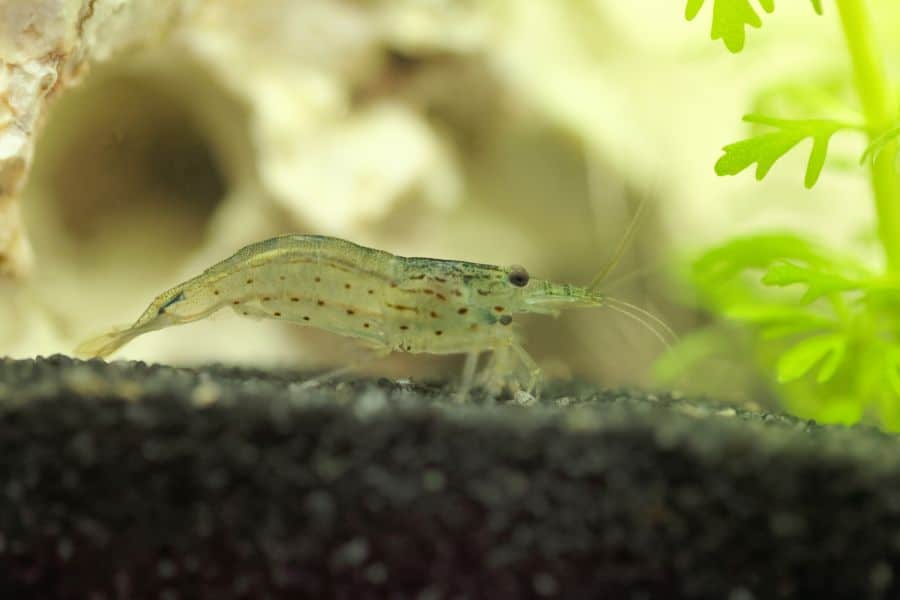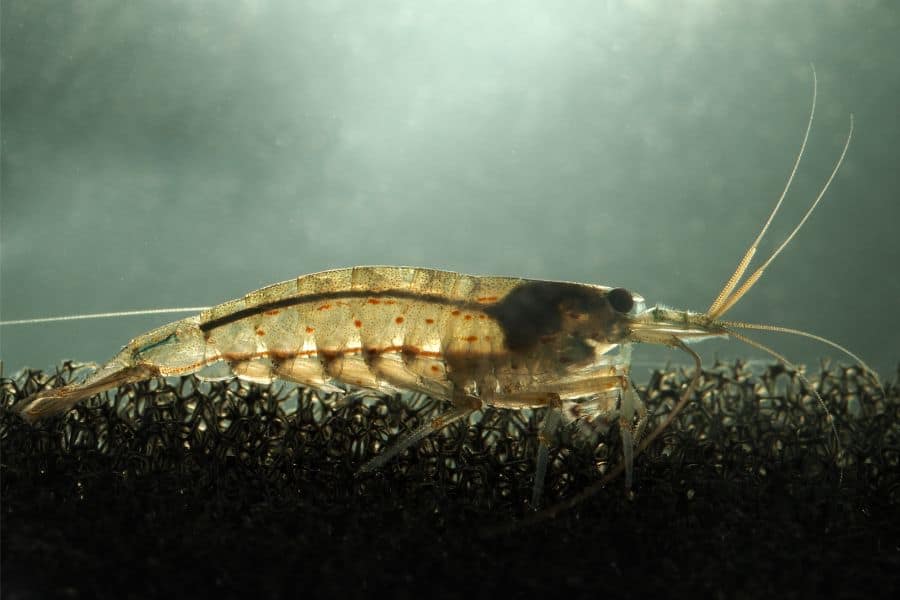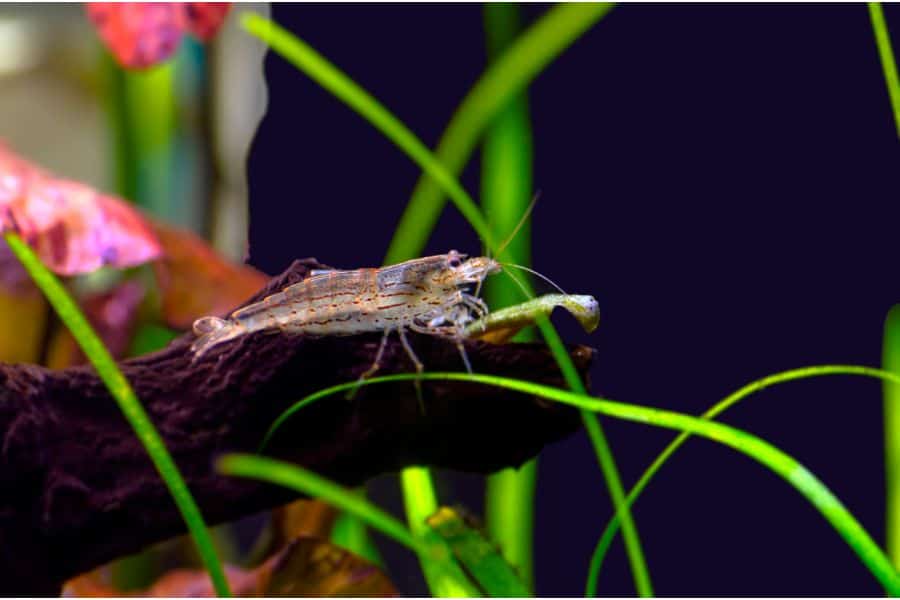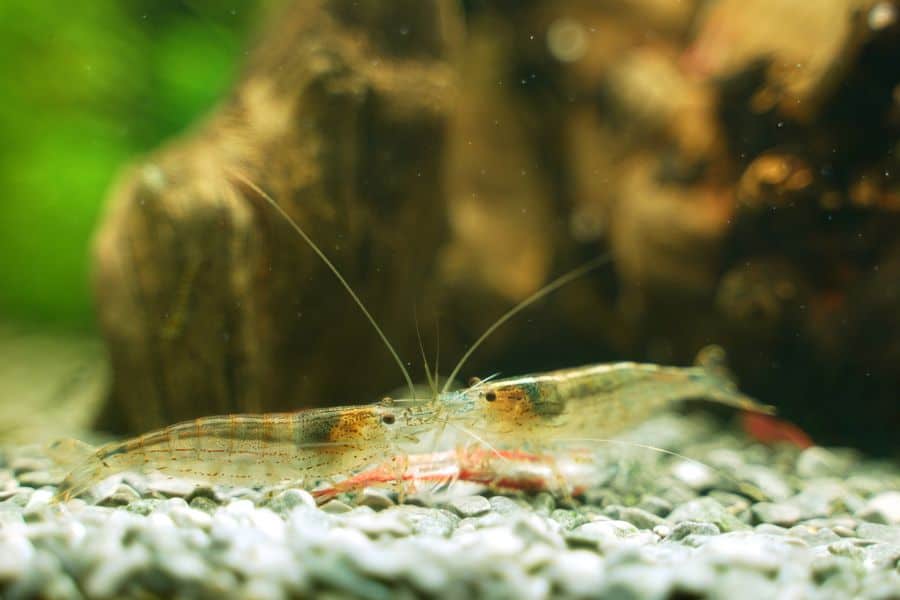If you’re a beginner fishkeeper looking for an interesting addition to your aquarium, the Amano shrimp is a fantastic choice. This peaceful shrimp species is slightly larger than many popular dwarf shrimp species, and they’re well-known for their tank-cleaning prowess.
In this article, we’ll cover all of the essential information about Amano shrimp care so that you can keep these interesting creatures healthy and thriving in your home aquarium. From their lifespan and ideal tank requirements to what kind of diet they prefer best – we’ve got everything you need to know covered here!
Amano Shrimp: Basics
| Scientific name | Caridina multidentata |
| Ease of care | Easy to moderate |
| Temperature range | 65 to 82°F (18°C to 27°C) |
| Temperament | Peaceful |
| pH | 6.5 to 7.5 |
| Lifespan | 3-5 years |
| Size | 1.5-2 inches |
| Typical diet | Omnivore but prefers a carnivorous, high-protein diet |
| Minimum tank size | 3-5 gallons |
| Ideal tank size | 5-10 gallons |
| Compatibility | Safe with other species of dwarf shrimp, small fish, and invertebrates |
Here are five important things you need to know about Amano shrimp.
- They eat algae: As algae-eaters, they’re often added to aquariums as part of the cleanup crew. They don’t mind ingesting uneaten food, decaying plant matter, and even dead fish. When there are not enough algae, though, you should consider feeding them algae wafers.
- They need calcium: Calcium is extremely important for an Amano shrimp’s well-being. Without enough calcium, they can suffer from various health issues, such as soft shells. They also run the risk of encountering more problems when molting.
- They’re sensitive to water quality: Amano shrimps are more sensitive to ammonia, nitrate, and copper buildups than many other aquarium species. Fish like Bettas can get sick from prolonged exposure to high levels of these toxins, but Amano shrimps can drop dead pretty quickly.
- They’re very hard to breed: Amano shrimps are ridiculously hard to breed. In fact, it was previously thought impossible to breed them. We now know this isn’t true, but it’s still very difficult and requires a lot of patience and dedication to pull off.
- They don’t handle strong currents well: Amano shrimp prefer still water, so they don’t do well in tanks with strong currents or powerful filters.
Amano Shrimp Origins
Amano shrimps originate from Japan, specifically from the region of the country formerly known as Yamato Province, now modern-day Nara Prefecture. They can also be found in various parts of the Korean peninsula as well as in Taiwan.
They were first popularized by Takashi Amano, the same aquarist who founded one of the most upscale and well-known aquarium companies in the world, Aqua Design Amano (ADA).
It was sometime in the 1980s when Takashi Amano first discovered that Japanese swamp shrimp (Caridina japonica) were incredibly efficient at eliminating algae from home aquariums.
Amazed at his discovery, Takashi ordered thousands of specimens from a trusted supplier and started distributing them. Soon enough, they started becoming popular with aquarium hobbyists around the globe.
Because of Takashi Amano, these shrimps are now commonly referred to as Safe with other species of dwarf shrimp, small fish, and invertebrates That said, they do go by many different names, depending on where you’re from. Here are just some of the names that Amano shrimp are known by:
- Algae-eating shrimp
- Japonica Amano shrimp
- Yamato shrimp
- Yamato numa ebi (lit. Yamato swamp shrimp)
- Japanese swamp shrimp
- Japanese marsh shrimp
In 2006, the species’ scientific name was changed to Caridina multidentata, derived from the Latin term meaning “multiple teeth.” This term was first used in a study published in 1860 by scientist William Stimpson, and the description matches the modern-day Caridina japonica.
What’s interesting to note is that Amano shrimp don’t have real teeth. The name comes from their rostrum, also known as the nose or the beak in shrimp species, which is lined with many thin teeth-like structures.
Amano Shrimp Appearance
Since Amano shrimps are difficult to breed in captivity, many of the specimens sold in stores are actually wild-caught.
It’s no wonder that they still have the coloration often found in wild species. Wild aquatic creatures typically need to rely on camouflage to protect themselves from predators, which is why they have dull colors most of the time.
The overall coloration of an Amano shrimp varies from a light, almost transparent blue or gray hue to a brownish or even greenish color. They have several dark spots on their body, though the appearance can vary based on their gender. Lastly, they also have a light-brown stripe that runs across their back.
Female vs. Male Amano Shrimp
It’s not very difficult to differentiate female from male Amano shrimp.
- Size: Males are usually smaller than females. Females have a bigger belly and are more robust in comparison.
- Patterns: Male Amano shrimp typically have rounded dots, while female Amano shrimp typically have short, broken lines.
- Shape: Male Amano shrimp have a much sharper abdomen compared to females, which tend to be rounder or more bulbous in shape.
- Egg spot: Obviously, males don’t have the egg spot behind their neck areas, unlike females.
That said, keep in mind that sexing young or juvenile Amano shrimp is much harder since they may not yet be fully showing their sexual dimorphism.
Amano Shrimp Size
Amano shrimp are small creatures, but they’re actually a bit bigger than most other dwarf shrimp.
Female Amano shrimp are usually around 5-6 cm (1.96-2.36 inches) in length, while males are about 4-5 cm (1.57-1.96 inches). The biggest specimens are around 7 cm or 2.75 inches.
Amano Shrimp Lifespan
The Amano shrimp average lifespan is around 3-5 years, but there are some reports saying that they can live up to 7 or even 10 years.
Keep in mind, though, that Amano shrimp are notorious for dying upon getting transferred to a new tank.
It’s such a common occurrence that many fishkeepers have already begun to anticipate it. Some even caution new fishkeepers against expecting all their shrimp to survive the initial transfer.
Amano Shrimp Temperament
Amano shrimp are fairly peaceful, but they’re extremely social animals that need to be with their kind in order to feel safe and comfortable. In fact, wild Amano shrimps tend to congregate in large colonies consisting of hundreds or even thousands of other Amanos.
Obviously, this might not be possible with the limited space of a home aquarium, but the least you can do is to have a minimum of 8-10 Amano shrimp in the tank.
When kept with compatible fish, they tend to get along very well. The only time that you may have a problem with Amano shrimp is when they’re feeding, as they can get quite greedy, even with each other. They’re unlikely to kill each other or anything like that, but minor injuries are not completely unheard of.
Additionally, they’re quite vulnerable due to their size and can easily get eaten by larger fish species. Make sure you put them with small or peaceful fish that won’t try to turn them into dinner.
Amano Shrimp Molting
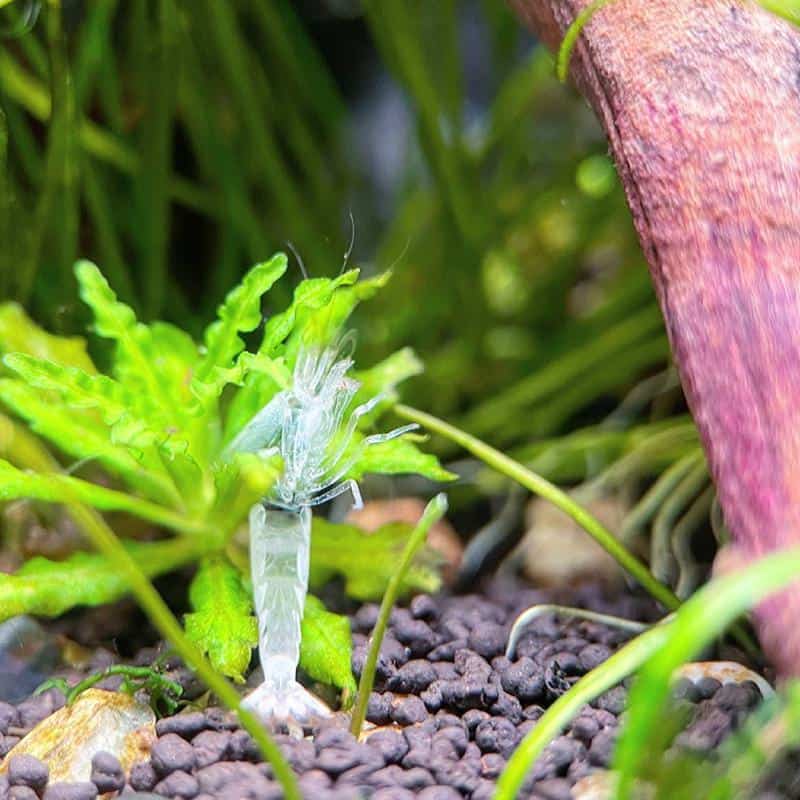
Amano shrimp, like other shrimp breeds, are also known for their molting behavior.
Molting is the process that Amano shrimp undergo to shed their old skin, also known as an exoskeleton. Their new exoskeleton will then harden and grow in the coming days.
During this time, Amano shrimp will look for a safe place to hide, as they’re very vulnerable while their exoskeleton still hasn’t fully developed.
If they’re disturbed or worse, injured, while molting, they may not survive it, as their skin underneath is very soft and fragile.
That’s why you should include plenty of hiding places when you’re planning to set up an Amano shrimp tank. Not only will this give your shrimp lots of things to do and places to explore, but it will also keep them safe when they’re molting.
How Often Do Amano Shrimp Molt?
As for how often they molt, it can vary from shrimp to shrimp, depending on several factors, such as age, diet, and environment.
On average, though, you can expect your Amano shrimp to molt every few weeks to every month. Remember, the faster your shrimp grows, the quicker it needs to molt. This is because they’ll need to support their fast-growing body by ‘replacing’ their skin. Molting also replaces any limbs they may have lost, so it’s very important for their health and well-being.
If you want to ensure the best outcomes for your shrimp, make sure you give them plenty of calcium-rich foods, as this will help to support their molting process. Some Amano shrimps also like eating their shed exoskeleton. You may want to leave it in your tank for another day or so just in case.
Problems With Molting
Fishkeepers who have experience caring for any shrimp species before will know that problems with molting are all too common.
One of the biggest and worst problems that you can get related to your Amano shrimp’s molting is the white ring of death.
If this sounds drastic to you, that’s because it kind of is. The white ring of death is the term given to the unfortunate situation when a shrimp, while molting, gets stuck and is unable to free itself from its old exoskeleton.
When this happens, the failed molt will look like a white continuous band around the shrimp’s head, where it meets the rest of the body.
This can be caused by many different factors, such as:
- Infrequent water changes
- Too large of a water change
- Malnutrition
- Incorrect water parameters
- Wrong temperatures
- Extreme stress
Again, if you want to avoid problems with molting in your Amano shrimp, you should keep the tank in tip-top shape and provide sources of calcium.
Amano Shrimp Tank Size
When it comes to Amano shrimp tank size, it’s safe to go for a minimum of 5 gallons. Some even recommend putting them in a 10-gallon tank.
That’s because Amano shrimp, even though they’re relatively small, love to explore their environment and forage on the substrate. Putting them in a small tank is limiting their space and can therefore make them stressed out.
Additionally, if you want a community tank, you need to take into account the size of the fish that you’ll be putting in with your shrimp as well. If you want to pair them with small peaceful fish, such as neon tetras, then 5 gallons might be enough.
But if you’re looking at a more diverse community, then you’ll need to consider getting at least 10 gallons.
How Many Amano Shrimp per Gallon
Since Amano shrimp can grow up to two inches, the ideal scenario is to have 2 gallons of water per shrimp. If you had 5 gallons, this means 3 shrimps.
However, this would make the ideal 8-10 shrimps per tank a bit difficult to comply with, especially for those who don’t have the space for a big tank.
That’s why we mainly recommend Amano shrimp to those who already have a decently sized community tank.
Amano Shrimp Tank Setup
Amano shrimp are quite versatile when it comes to tank requirements. They thrive best in tanks that emulate their natural swampy environments, and that means a lot of vegetation.
You can use live plants as decorations, but make sure they’re not the kind that will easily be uprooted when the shrimps are scavenging.
Small rocks, pebbles, or stones are also great additions to an Amano shrimp. Amano shrimps love to hide between them and forage on them.
Amano Shrimp Care
Like other shrimp species, Amano shrimp need a healthy environment to thrive. Here are some things to keep in mind when it comes to Amano shrimp care.
Amano Shrimp Temperature
Amano shrimp can be sensitive to temperatures. They can handle slight changes in temperature, but not anything more than the regular temperature changes experienced from morning to night and versa.
The ideal temperature range for Amano shrimp is 72°F to 77°F (22°C to 25°C) but they can also survive in 65 to 82°F (18°C to 27°C). Anything above or below this range can make them sick or worse.
For best results, you can use a heater to make the water warmer or a fan to cool it down, based on the time of the year. Make sure to avoid placing the aquarium under direct sunlight and keep it away from sources of heat like heating vents or radiators.
Amano Shrimp Water Parameters
When it comes to water parameters, Amano shrimp are pretty flexible. They can live in both soft and very hard water, and they can also tolerate a wide range of pH.
Ideally, it should be 6.5 to 8 with the ideal being 7.0. Meanwhile, the hardness should stay between 5 and 14 dGH and 1 and 7 dKH.
That said, shrimps are very sensitive to high copper amounts in the water. Copper can be incredibly toxic to shrimps, as it can interfere with their internal systems, such as digestive, reproductive, and immune systems.
Amano Shrimp Diet
Amano shrimp eat a very diverse diet. In the wild, they can eat anything from algae to decaying leaves and decaying meat.
In the home aquarium, Amano shrimp can eat biofilm that forms on the surface. They also eat the algae that form on top of the leaves of plants and decorations.
In fact, they’re known to be aggressive algae eaters and are good at eradicating even the worst algae in aquariums, such as black brush algae. This is a type of algae notorious for being difficult to remove, but Amano shrimp can eat them all away in just a matter of days.
They love algae, which is why it’s recommended that you don’t keep your shrimp in a tank that’s too clean.
Aside from algae, you can feed them frozen food, pellets, or algae wafers. You can also give them blanched vegetables, including zucchini and spinach. Additionally, make sure you get their calcium needs in by giving them shrimp treats, as this can help them avoid problems when they molt.
However, contrary to popular belief, they don’t like dead plants. You still need to remove those manually if you want to keep your tank clear of this type of debris.
Amano Shrimp Common Diseases
Amano shrimp are a popular choice for many aquarium hobbyists due to their hardy nature and interesting appearance.
However, they can still develop diseases if not properly cared for. Here are some of the common diseases that Amano shrimp can develop in a home aquarium.
- Fungal Diseases. Amano shrimp are quite prone to infections caused by fungi. This is typically caused by overcrowding in the tank, poor water quality, or exposure to toxins or chemicals. Sometimes, this is also called fusariosis or black gill disease.
- Planaria: Flatworms are not uncommon in dirty aquariums, particularly those that have a lot of uneaten food. They can cause health problems for Amano shrimps, so it’s important to keep an eye on your tank and do regular maintenance.
- Vorticella. Vorticella is a parasitic infection that can be caught by freshwater shrimp, including Amano shrimps. It’s not usually that serious, but if they happen to get into the shrimp’s gills, it can cause them to suffocate and eventually die.
- Muscle Necrosis. Muscle necrosis is a pretty serious problem in Amano shrimps. One of the main signs is solid white lesions in your shrimp’s tail. It’s usually caused by viruses, wrong temperatures, poor tank conditions, and toxins, but it’s also exacerbated by poor nutrition. Be wary when you see this in your shrimp, as it can be a mere symptom of a bigger health concern.
Amano Shrimp Breeding
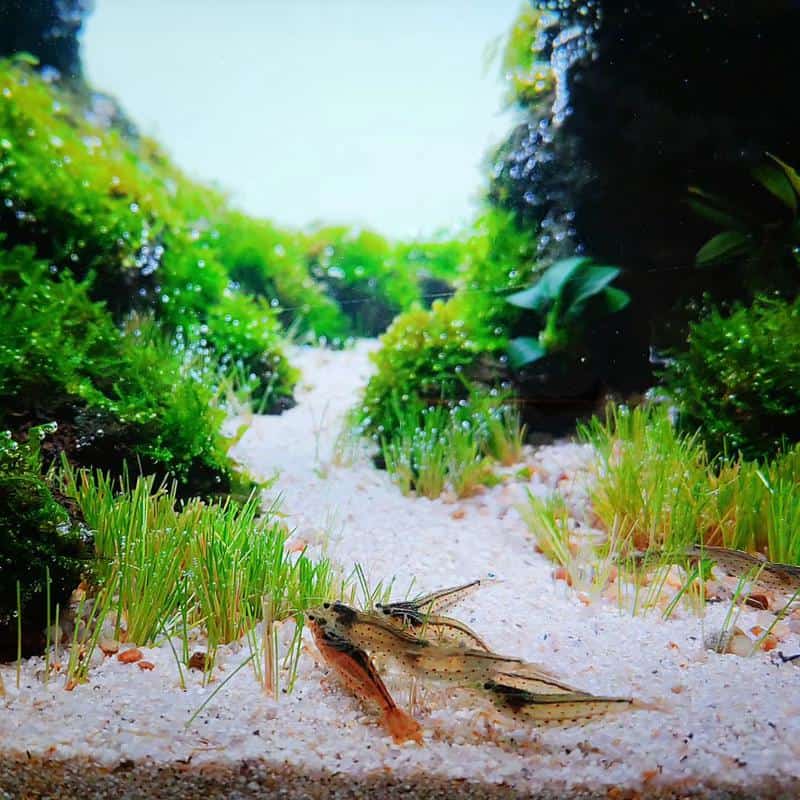
Amano shrimp breeding is possible, but it’s very difficult.
Amano shrimps themselves can ‘mate’ inside a home aquarium, but whether the babies will survive is a different matter altogether.
That’s because amano shrimp eggs are very sensitive and won’t survive if the parameters aren’t entirely correct. They need brackish water to hatch, and once they do, they’ll need to be ‘taught’
how to live in freshwater. And acclimating young Amano shrimps to freshwater is not something many aquarists have successfully done in the past.
Still, if you’re up for the challenge, here’s how the process goes.
- If you have your shrimps in a community tank, you can get a separate tank where you can keep the adults in the meantime. Keep in mind that you don’t really have to do this as Amano shrimps will try to breed once they’re sexually mature at around 4-5 months of age.
- If you do decide to put them in a separate tank, you may have to wait for a while for something to happen. Female Amanos take 6 weeks for a full cycle. Once she’s ready, she will release pheromones around her that will make the males go wild.
- After a male manages to mate with the female, the female will then develop eggs inside her body. She’ll carry these eggs for around 5 weeks. We call this the berry stage.
- Get a 1-gallon tank with an air pump and bubbler and transfer the female there. In about 5 weeks, the babies will be ready to hatch, and these larvae will be very tiny. The water needs to be well-oxygenated for them to stay healthy during this time.
- Keep close attention to the berried female. Once the larvae hatch, you’ll want to use a flashlight to bait them into going into just one corner of the tank, allowing you to scoop them up easier and move them into a temporary container.
- Remember, the eggs won’t hatch all at once, so you may have to do a lot of baiting, scooping, and moving. You can let these hatchlings stay in freshwater for up to a week. After that, they will die if you don’t move them to a saltwater tank with an air pump and bubbler.
- The Amano shrimp larvae will need to stay in the saltwater tank for a total of 2-3 months. Let them float inside the tank and eat the algae that develop on the walls of the tank. The best way to give them enough algae is to simply turn on the aquarium light for a few hours too long per day.
- If there aren’t enough algae for them to eat, you can use spirulina powder, too. It doesn’t have to be a whole lot – a pinch will be enough to fit a whole container of larvae.
- In 2-3 months, they’ll metamorphose into actual baby shrimps. You can now transfer them into freshwater, but you’ll have to acclimate them for about 3 days first. You can do this by slowly adding freshwater into their saltwater container until it’s fully replaced.
- After this, you can set up the parameters in their final tank according to the adult Amano shrimp requirements.
Also Read:
FAQs
Do Amano Shrimp Eat Their Own Young?
Amano shrimp don’t eat their own young, but they can’t live in the same conditions as them. That’s because, in the wild, Amano shrimp give birth to their offspring in saltwater or brackish waters, who then have to travel by themselves back to freshwater once they’re old enough. You’ll have to duplicate this scenario inside the aquarium for a successful Amano shrimp breeding process.
How Do I Know My Baby Amano Shrimp Has Metamorphosed?
A baby Amano shrimp that has metamorphosed looks exactly like a tiny version of an adult Amano. You may have to use a magnifying glass to be sure.
Can Amano Shrimp Live Without Soil?
Amano shrimp can survive without soil, but they do best with some form of substrate. They use substrate both as entertainment and protection and without these, they can get stressed and fall ill.
Conclusion
Amano shrimp are fascinating little creatures that deserve a spot in any community tank. They do need a bit of care, but once you’ve got the tank setup and ready the way they need it to be, you should be able to enjoy these peaceful creatures for many years.
On the other hand, breeding Amano shrimps can be quite a challenge, especially since they have very stringent requirements. But they can be very rewarding, as well, so if you’re willing to take on the challenge, you can find success in producing a whole colony of these lovely little animals!
